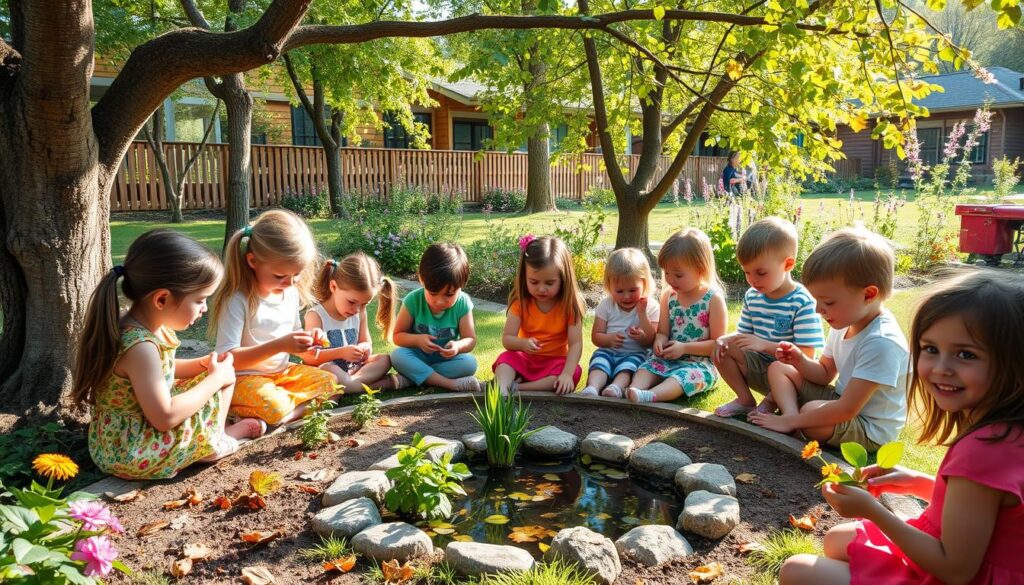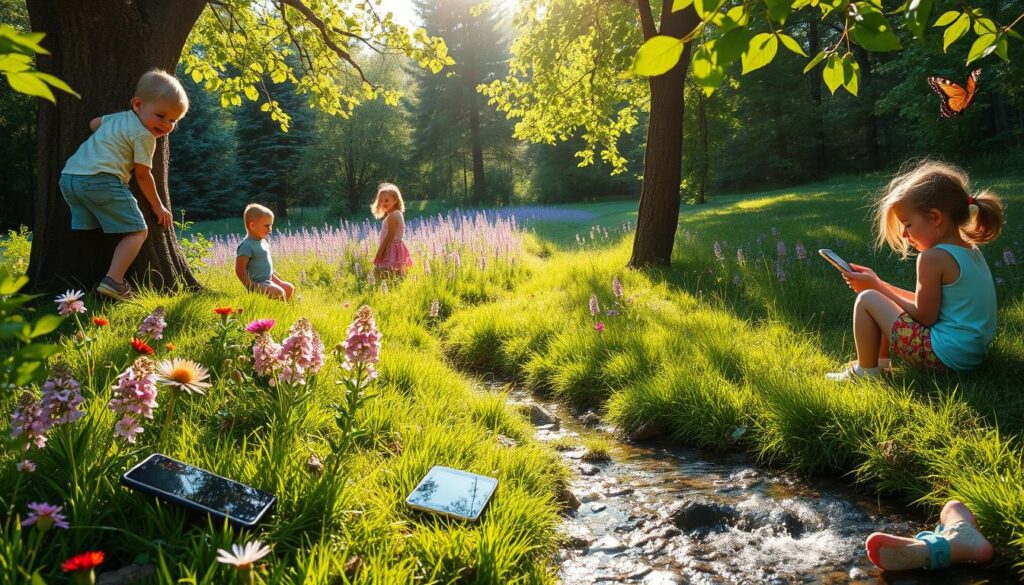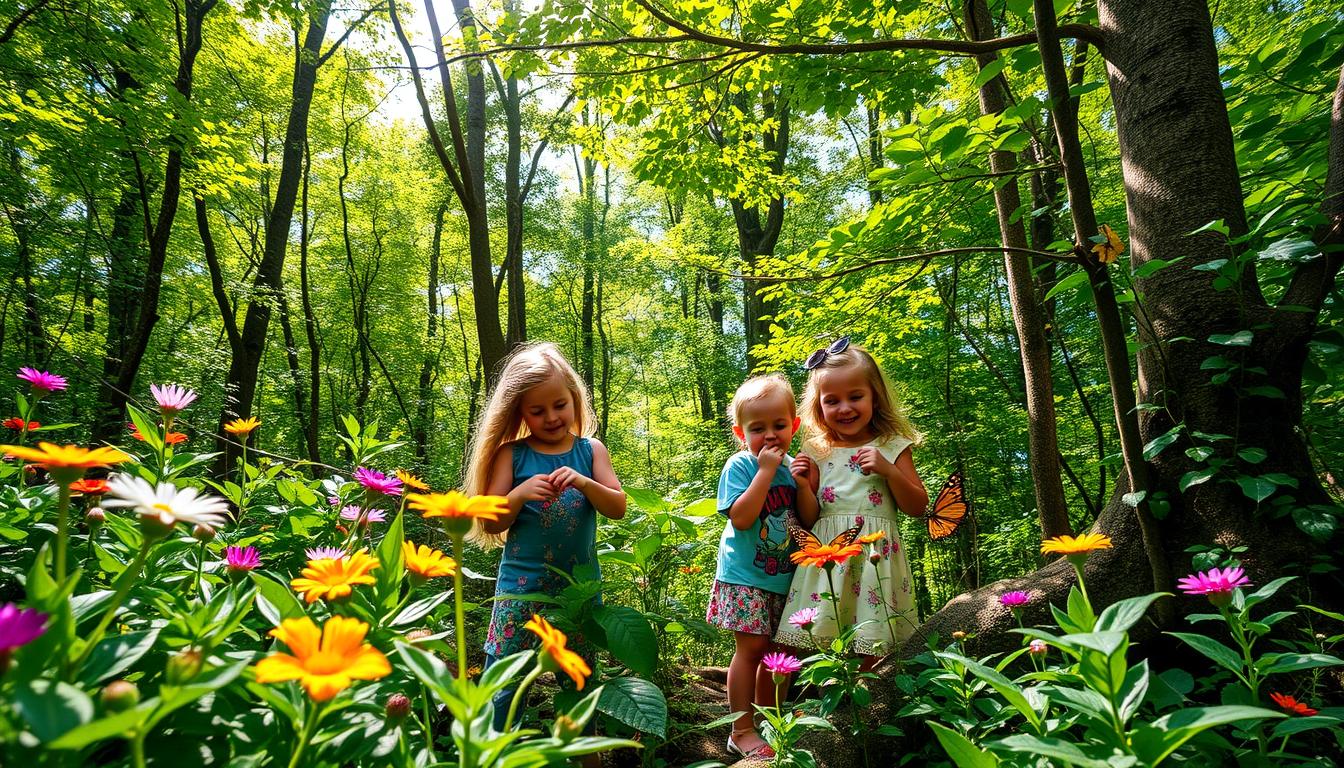Did you know the average American child spends only 4-7 minutes outside each day? This is compared to over 7 hours of screen time. This shows how much kids need nature therapy in our tech-filled world.
As a parent and outdoor lover, I’ve seen how nature changes kids for the better. Outdoor play is more than fun—it’s key for growing up right. Nature therapy is a great way to counteract the digital life that kids live today.
Today’s kids are losing touch with nature, missing out on important experiences. By bringing nature into their lives, we help them grow physically, emotionally, and mentally. This is something screens can’t offer.
Key Takeaways
- Nature therapy provides critical developmental experiences for children
- Minimal outdoor play time is negatively impacting child development
- Outdoor activities support physical and mental health
- Technology should be balanced with natural experiences
- Reconnecting with nature improves overall child well-being
Understanding Nature Therapy and Its Benefits for Children
Nature therapy is a new way to help kids grow and feel better. It uses eco-therapy and green exercise. Kids today spend too much time indoors and staring at screens. Nature helps them develop in amazing ways.
Learning about nature therapy can change how we help kids. It shows the many good things about letting kids play outside.
Physical Health Benefits of Nature Exposure
Nature is a great place for kids to get active. Green exercise lets them:
- Improve their heart health
- Get better at moving their bodies
- Keep their immune system strong
- Move more
Mental and Emotional Advantages
Eco-therapy is also good for kids’ minds. Being in nature helps them relax, think creatively, and control their feelings. Studies show that kids who spend time outside:
- Feel less anxious
- Focus better
- Stay happier
- Deal with tough times better
“Nature is the ultimate classroom for childhood development.” – Child Psychology Research Institute
Social Development Through Nature Activities
Nature helps kids learn to work together. Outdoor activities teach them to communicate and explore as a team. They learn important skills like teamwork and problem-solving.
Nature therapy is a way to help kids grow in all areas. It supports their physical, mental, and social development.
Nature Therapy for Kids: Reconnecting with Nature for Improved Well-being
Getting kids to connect with nature is key in today’s digital world. Biophilic design in playgrounds is a great way to help them bond with nature. It makes outdoor spaces fun and full of natural elements, changing how kids see their world.
“Nature is the greatest teacher and healer for children,” says environmental psychologist Dr. Rachel Green.
Learning about nature is important for kids. It helps them understand and value the natural world. Through special experiences, they learn about ecosystems, biodiversity, and how to stay healthy.
- Implement sensory-rich outdoor learning environments
- Create interactive nature exploration zones
- Develop hands-on ecological learning programs
Playgrounds with biophilic design are good for kids’ health. They use natural materials, plants, and changing landscapes. These encourage kids to play and explore in new ways.
| Design Element | Benefits for Children |
|---|---|
| Natural Materials | Improves sensory development |
| Living Landscapes | Enhances environmental awareness |
| Dynamic Spaces | Stimulates creativity and physical activity |
By focusing on nature, we help kids love the environment and themselves. The goal is to create meaningful connections that inspire curiosity, learning, and personal growth.
Getting Started with Forest Bathing for Children
Introducing kids to forest bathing opens a world of adventure in nature. It’s more than just playing outside. It’s about making real connections with nature.
Forest bathing for kids is not just a walk. It’s a way to deeply connect with nature through our senses. It helps kids love the outdoors more.
Safe Forest Bathing Practices
When we go on wilderness adventures with kids, safety is key. Here are some important rules:
- Always choose well-marked trails
- Dress appropriately for the weather
- Carry a first aid kit
- Stay hydrated
- Use protective sunscreen and insect repellent
Seasonal Activities for Forest Bathing
| Season | Activities |
|---|---|
| Spring | Wildflower identification, bird watching |
| Summer | Creek exploration, leaf collecting |
| Autumn | Leaf pressing, mushroom spotting |
| Winter | Snow tracking, evergreen tree identification |
Essential Equipment and Preparations
To prepare for forest bathing, you’ll need some special gear. It makes the experience fun and educational:
- Comfortable walking shoes
- Lightweight backpack
- Water bottles
- Nature guidebooks
- Magnifying glass
- Notebook for observations
“In every walk with nature, one receives far more than he seeks.” – John Muir
By starting forest bathing with kids, parents can foster a lifelong love for nature. It helps kids become more aware of the environment. And it creates unforgettable memories of nature adventures.
Creating Natural Play Spaces at Home
Designing outdoor spaces that connect children with nature is key for modern parents. By using biophilic design, you can turn your backyard into a fun learning area. It encourages kids to enjoy the outdoors.
Creating natural play spaces doesn’t need big landscaping or pricey gear. Simple steps can greatly change how kids play outside.
- Use natural materials like logs, stones, and tree stumps for seating and climbing
- Incorporate native plants that attract butterflies and birds
- Create sensory exploration zones with different textures and surfaces
- Design mud kitchens and water play areas
“Nature is the ultimate playground for curious minds.” – Environmental Education Expert
Here are some key elements for a kid-friendly outdoor area:
| Element | Benefits | Implementation |
|---|---|---|
| Garden Patch | Teaches responsibility, understanding of plant growth | Small raised bed with child-friendly vegetables |
| Sensory Path | Develops tactile awareness | Mixed ground surfaces like pebbles, grass, sand |
| Natural Climbing Area | Builds physical strength, spatial awareness | Wooden logs, small hills, safe climbing structures |
Remember, the goal is to create an inviting space that sparks imagination and connects children with the natural world around them.
Wilderness Adventures and Outdoor Learning Activities
Exploring the outdoors with kids opens a world of discovery. It teaches them about nature and helps them appreciate it. They learn valuable skills and develop a lifelong love for nature.
Planning outdoor activities for kids is key. The right plan turns a simple walk into an exciting learning journey. It sparks curiosity and wonder.
Age-Appropriate Nature Exploration
Each age group needs a different approach to nature adventures. Young kids need fun, safe activities that spark their imagination.
- Toddlers (1-3 years): Short nature walks with frequent stops
- Preschoolers (3-5 years): Simple nature collections and sensory experiences
- Elementary kids (6-10 years): More complex nature identification challenges
- Tweens (10-12 years): Longer hiking and basic survival skill learning
Nature Scavenger Hunts and Games
Turning learning into games makes it fun and memorable. Scavenger hunts help kids observe and interact with nature.
| Game Type | Learning Objective | Age Group |
|---|---|---|
| Color Scavenger Hunt | Identify natural objects by color | 3-6 years |
| Wildlife Bingo | Learn animal and plant identification | 7-12 years |
| Ecosystem Detective | Understand habitat interactions | 10-14 years |
Wildlife Observation Tips
Watching wildlife needs patience and respect. Teach kids to observe quietly and keep a safe distance from animals.
“In nature, nothing is perfect and everything is perfect.” – Alice Walker
- Use binoculars for safe, distant observation
- Teach leave no trace principles
- Keep noise levels low
- Respect animal habitats
Wilderness adventures are more than fun activities. They are experiences that shape kids’ environmental awareness and critical thinking. They help kids connect deeply with nature.
Integrating Nature-Based Learning in Daily Routines

Adding nature-based learning to daily life is easy. As a parent, I’ve found simple ways to make eco-therapy fun for kids. It makes learning exciting and meaningful.
“Nature is the greatest classroom, and every moment can be a learning opportunity.” – Environmental Education Expert
Here are some easy ways to bring nature into your daily life:
- Morning Nature Observations: Start the day by spending 10 minutes outside, noting weather changes, bird activities, or plant growth
- Kitchen Garden Projects: Grow herbs or vegetables in small containers, teaching children about plant life cycles
- Nature-Inspired Homework: Encourage drawing, writing, or math problems using natural elements
- Evening Reflection Time: Discuss daily nature encounters during family time
Eco-therapy turns everyday moments into learning experiences. By making nature a part of daily life, kids learn and appreciate nature more.
| Daily Activity | Nature Learning Opportunity |
|---|---|
| Breakfast | Discuss food origins, seasonal produce |
| Commute | Observe local wildlife, plant species |
| Playtime | Collect leaves, rocks, engage in outdoor sensory play |
| Bedtime | Read nature-themed books, share daily discoveries |
By using these nature-based methods, families can connect with the environment. This fosters curiosity, respect, and a lifelong love for nature in kids.
Environmental Education Through Hands-on Experiences
Connecting kids with nature is more than just outdoor time. It’s a chance for them to learn and grow. They can develop a deep love for the natural world through fun, interactive experiences.
Hands-on learning makes environmental education real and exciting. It lets kids understand ecological systems and how to protect our planet. This way, they see their role in keeping the Earth green.
Garden Projects for Kids
Starting a home garden teaches kids about ecosystems and responsibility. Some cool projects include:
- Growing vegetable gardens from seeds
- Creating butterfly and pollinator gardens
- Composting kitchen scraps
- Tracking plant growth and biodiversity
Nature Journaling Activities
Nature journaling helps kids observe, document, and think about their outdoor adventures. It boosts:
- Observation skills
- Scientific recording techniques
- Creative expression
- Environmental awareness
Conservation Learning Opportunities
| Conservation Activity | Learning Outcome |
|---|---|
| Beach or park clean-up | Understanding waste management |
| Wildlife habitat restoration | Ecosystem preservation |
| Local watershed monitoring | Water resource protection |
By making environmental education a part of daily life, we teach kids to care for our planet. They become informed and passionate about protecting nature.
Overcoming Modern Barriers to Nature Connection

In today’s world, it’s hard to connect with nature for our well-being. Kids spend a lot of time indoors, staring at screens. This limits their chances to enjoy the outdoors. It’s important to tackle these barriers for their growth.
“Nature is not a place to visit. It is home.” – Gary Snyder
The main hurdles for kids to experience nature are:
- Too much screen time
- Busy city environments
- Concerns about safety
- Not enough green areas
We can overcome these challenges with smart planning and creative ideas. Intentional planning and new approaches can bring back the fun of exploring outside for kids.
| Barrier | Solution |
|---|---|
| Screen Addiction | Set daily technology limits |
| Urban Constraints | Create backyard nature experiences |
| Safety Worries | Supervised outdoor group activities |
By using these solutions, we can help kids reconnect with nature. This promotes physical health, mental strength, and a better understanding of the world.
Conclusion
Nature therapy for kids is more than just playing outside. It’s a way to help kids grow in a holistic way. By exploring nature, kids can learn and heal in unique ways.
Being in nature has many benefits for kids. It helps them physically, mentally, and emotionally. Nature can reduce stress, boost their immune system, and improve their creativity and problem-solving skills.
Parents and caregivers are key in giving kids these nature experiences. Simple actions like creating a backyard nature space or planning outdoor activities can make a big difference. It’s important for kids to connect with nature to grow up healthy and balanced.
I urge families to make nature a priority. Whether it’s a visit to a park, a garden in your backyard, or a hike, every moment in nature is valuable. It helps shape compassionate and environmentally aware kids, which is essential for our future.



